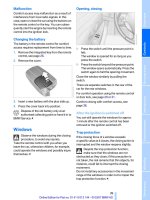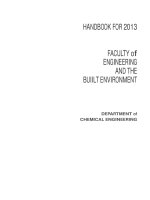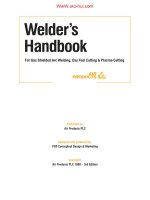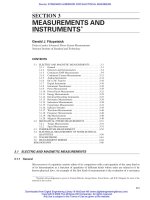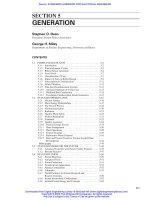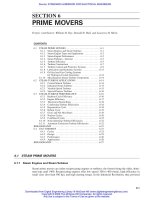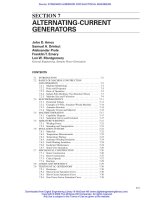Wu column handbook for size exclusion chromatogrаphy
Bạn đang xem bản rút gọn của tài liệu. Xem và tải ngay bản đầy đủ của tài liệu tại đây (20.3 MB, 635 trang )
Column Handbook
for Size Exclusion
Chromatogruphy
Edited by
C h i-s a n W u
International Specialty Products
Wayne, New jersq
0kp
A C A D E MIC PR E SS
San Diego London Boston New York Sydney Tokyo Toronto
- CONTENTS
CONTRIBUTORS xix
PREFACE xxi
m CONTRIBUTIONS FROM SIZE EXCLUSION
CHROMATOGRAPHY AND GEL-FILTRATION
CHROMATOGRAPHY COLUMN MANUFACTURERS
1 Preparation of Beaded Organic Polymers and Their
Applications in Size Exclusion Chromatography
MICHAEL J. LU
I. Introduction 3
II. Basic Features of Conventional Suspension Polymerization 4
A. Droplet Formation 4
B. Droplet Stabilization 5
C. Particle Size and Pore Size 5
III. Preparation of Organic Polymeric Beads by Conventional Suspension
Polymerization 7
A. Polystyrene/Polystyrene-Divinylbenzene 7
B. Polyacrylamide-Polymethacrylate 9
C. Polyvinyl Alcohol 9
CONTENTS
IV. Special Polymeric Supports 10
A. Templated Polymeric Supports 10
B. Pore-Matrix Composite Supports 10
C. Dual Functionality of Polymeric Supports 11
D. Continuous Rods of Macroporous Polymeric Supports 14
E. Porous Perfusion Particles 14
V. Basic Features of Monosized Polymeric Particles Prepared by
Activated Swelling and Polymerization 15
A. Monosized Seed Particles 15
B. Activated Seed Particles 16
C. Swelling of the Activated Seed Particles with Monomers or a
Mixture of Monomers 17
D. Polymerization of Multistep Swelling Particles 11
E. Preparation of Monosized Macroporous Particles 18
VI. Application of Polymeric Beads as Size Exclusion Chromatography
Supports 1 9
A. Polystyrene-Divinylbenzene-Based Resin 21
B. Polyacrylamide- and Polymethacrylate-Based Gels 22
C. Polyvinyl Alcohol-Based Gels 22
D. Application of Monosized Polymeric Particles in Size Exclusion
Chromatography 23
References 24
2 Size Exclusion for Analysis and Purification of
Aqueous Macromolecules
ALAN WILLIAMS AND LARS HAGEL
I. Introduction: Development of Size Exclusion Chromatography
(SEC) 27
II. Application Areas of SEC 29
A. Determination of Molecular Size and Sample Purity 29
B. High-Resolution Fractionation 35
C. Desalting (Group Fractionation) 36
III. Characteristics of Gel-Filtration/Size Exclusion Media 39
A. Sephadex 39
B. Sepharose 4 1
C. Sephacryl 44
D. Superose 46
E. Superdex 49
IV. Columns for Packing SEC Media 54
A. C Columns 55
B. XK Columns 55
C. SR Columns 56
D. HR Columns 56
E. INdEX Columns 57
F. FineLINE Columns 58
G. BPG Columns 59
CONTENTS
H. BioProcess Stainless-Steel Columns 59
I. Stack Columns 59
V. Preparation of the Size Exclusion Column 61
A. Selection Criteria for Empty Columns 61
B. General Packing Methodology 62
C. Qualification of Column Packing 64
D. Typical Results for Self-Packed Columns 66
VI. Optimization of Gel-Filtration/Size Exclusion Separations
A. Selectivity 67
B. Separating Volume 67
C. Plate Height 69
D. Column Length 69
E. Sample Load 69
F. Analytical Gel Filtration 70
G. Preparative Gel Filtration 71
H. Desalting 72
References 73
67
3 Zorbax Porous Silica Microsphere Columns for HighPerformance Size Exclusion Chromatography
ROBERT T. MOODY
I. Background Information 7.5
A. Development of Silica Particles for High-Performance Size
Exclusion Chromatography (HPSEC) 75
B. Advantages and Disadvantages of Porous Silica Packings for
HPSEC 76
C. Manufacture of Zorbax Porous Silica Microspheres (PSM) 76
D. Separation Mechanism 77
II. Using and Selecting Zorbax PSM Columns and Mobile Phases 78
A. Conducting HPSEC Experiments with Zorbax PSM Columns 78
B. Selecting Columns and Mobile Phases for HPSEC 79
III. HPSEC Troubleshooting 82
IV. Applications 85
A. General Applications 85
B. Special Applications: Proteins 86
References 92
Bibliography 92
4 Size Exclusion Chromatography Using TSK-GEL Columns and
Toyopearl Resins
YOSHIO KATO, J. KEVIN O’DONNELL, AND JON FISHER
I. Silica-Based TSK-GEL SW/SWxL Columns for Gel-Filtration
Chromatography (GFC) 93
A. Description 93
CONTENTS
II.
III.
IV.
V.
VI.
B. Conditions 94
C. Applications 102
D. Preparative TSK-GEL SW Columns 104
Polymer-Based TSK-GEL PW/PWxr Columns for Aqueous
GFC 106
A. Description 106
B. Conditions 106
C. Applications 118
Choosing TSK-GEL SW Type or TSK-GEL PW Type Columns for
GFC 128
Cleaning and Rehydration of TSK-GEL Columns 134
A. Cleaning Procedures 134
B. Rehydration Procedure 135
TSK-GEL H Type Columns 135
A. Introduction 135
B. Product Offerings 136
C. Limitation of Operation 138
D. Separation Conditions 141
E. Applications 145
Toyopearl Resins for Size Exclusion Chromatography 145
A. Advantages of Toyopearl HW Resins 148
B. Optimizing Separation Conditions 153
C. Applications 154
References 157
5 American Polymer Standards Columns for Size
Exclusion Chromatography
JOHN E. ARMONAS AND BRIAN H. PEABODY
I. Introduction 159
II. American Polymer Gel-Permeation/Size Exclusion Chromatography
(GPC/SEC) Column Repacking 160
III. GPC/SEC Styrene-Divinylbenzene Gel 163
IV. Manufacture of GPUSEC Gels 163
A. Discussion 163
B. Experimental 164
C. Optimizing the Formulation 166
D. Classification of the GPC/SEC Gel 168
E. Packing and Testing GPC/SEC Columns 168
V. Conclusion 169
References 169
ix
CONTENTS
6
Shodex Columns for Size Exclusion Chromatography
HIROSHI SUZUKI AND SADAO MORI
I. Introduction 171
II. Gel Technology of Shodex Columns 171
III. Shodex Organic GPC Series 172
A. Column Characteristics 172
B. Application Examples 189
IV. Shodex OHpak SB-800HQ Series 193
A. Column Characteristics 193
B. Application Examples 193
C. Preparative and Semipreparative Columns 197
V. Shodex Asahipak GYGF Series 197
A. Column Characteristics 2 97
B. Application Examples: 198
C. Preparative and Semipreparative Columns 200
VI. Shodex Protein KW Series 204
A. Column Characteristics 204
B. Application Examples 205
C. Preparative and Semipreparative Columns 210
VII. Conclusion 210
7 Size Exclusion Chromatography on Fractogel EMD BioSEC
LOTHAR R. JACOB AND LOTHAR BRITSCH
I.
II.
III.
IV.
V.
VI.
VII.
VIII.
IX.
X.
XI.
XII.
Introduction to Size Exclusion Chromatography (SEC) 219
Synthesis of Fractogel EMD BioSEC 220
Properties of Fractogel EMD BioSEC 221
Adequate Buffers 222
Recommended Columns for SEC 224
Packing the Column 226
A. Preparing the Gel 228
B. Packing a Superformance 600-l 6 Column 228
C. Packing of Preparative Columns 229
D. Checking the Quality of the Packed Gel Bed 230
Recommended Flow Rates for SEC Columns 232
Loading Capacity 233
Determination of Molecular Mass of Proteins 235
Column and Gel Maintenance, Cleaning, Regeneration, and Storage
Methods 237
Application Areas 241
Troubleshooting 246
References 247
X
CONTENTS
8
Size Exclusion High-Performance Liquid Chromatography of
Small Solutes
ANDREW J. ALPERT
I. Overview of Size Exclusion Chromatography (SEC) of Small
Solutes 249
II. Introduction of PolyHYDROXYETHYL Aspartamide and the Effect
of Chaotropes on the Fractionation Range 250
III. Verification of SEC Mechanism for Small Solutes 254
A. Effect of pH 255
B. Effect of Salt 257
C. Effect of Organic Solvents 258
D. How Big Are Amino Acids? 259
E. Superdex Peptide 260
IV. Fractionation Range with PolyHEA as a Function of Pore
Diameter 260
V. Applications 265
A. SEC of Peptides and Amino Acids 265
B. SEC of Small Solutes Other Than Peptides 265
C. Mass Spectrometry: On-Line Desalting 265
References 265
9 Design, Properties, and Testing of Polymer Standards Service
Size Exclusion Chromatography (SEC) Columns and
Optimization of SEC Separations
P. KILZ
I. Introduction 267
II. Basis of SEC Column Design 268
A. Major SEC Column Design Characteristics 269
III. Review: SEC Sorbents and Requirements 270
IV. SEC Column Selection Criteria 271
A. Chromatographic Modes of Column Separation 272
B. Selection of Pore Size and Separation Range 27.5
C. Influence of Particle Size on Separation Eficiency 278
D. Influence of Column Dimensions 281
E. Influence of Operating Parameters 282
V. Testing and Evaluation of SEC Columns 283
A. Calculation of Plate Count 284
B. Determination of Peak Asymmetry 286
C. Calculation of Resolution 287
D. Calculation of Efficiency 287
VI. PSS Column Quality Control System 287
A. Raw Materials 287
B. Sorbent Manufacturing 288
C. Testing of Sorbents 288
D. Column Packing Process 289
XI
CONTENTS
VII. Applications of PSS SEC Columns 291
A. Organic SEC Applications 291
B. Aqueous Applications 291
C. Applications of PSS Polar Fluoro Gel Columns
VIII. Conclusion 298
References 303
295
IO SynChropak, Size Exclusion Columns
KAREN M. GOODING
I. Introduction 305
II. Support Technology 306
A. Physical Properties 306
B. Chemical Properties 306
C. Calibration 306
D. Quality Assurance 3 2 0
III. Column Technology 3 10
A. Hardware 3 1 0
B. Packing Techniques 3 12
C. Quality Control 314
IV. Operation 314
A. Mobile Phase Selection 314
B. Flow Rate 316
C. Loading 3 1 8
D. Restrictions 318
V. Applications 323
References 323
1 1 Waters Columns for Size Exclusion Chromatography
UWE DIETER NEUE
I. Introduction 325
II. Column Selection Principles 326
A. Packing Type 326
B. Pore Size Selection 328
C. Particle Size Selection 332
D. Narrow-Bore Columns 333
III. Waters Products for Size Exclusion Chromatography 335
A. The Styragel Line of Size Exclusion Columns 33.5
B. The Ultrahydrogel Line of Size Exclusion Columns 343
C. The Protein-Pak Line of Size Exclusion Columns 346
IV. Summary 347
References 348
xii
CONTENTS
12 Size Exclusion Chromatography Columns from
Polymer Laboratories
ELIZABETH MEEHAN
I. Introduction 349
II. PLgel Organic Size Exclusion Chromatography (SEC) Columns
A. PLgel Individual Pore Size Columns 350
B. PLgel Mixed Gel Columns 353
C. PLgel Column Performance Testing 355
D. Column Selection and Operation 3.55
III. PL HFIPgel Columns 359
IV. PL aquagel-OH Aqueous SEC Columns 360
V. Column Hardware 363
A. Narrow-Bore SEC Columns 364
B. Preparative SEC Columns 365
VI. Summary 366
References 366
13 Jordi Gel Columns for Size Exclusion Chromatography
HOWARD JORDI
I. Introduction 367
II. The Basic Polydivinylbenzene Packing 368
III. Basic and Chemically Modified Polydivinylbenzene
Packings 372
IV. Modified GBR/PDVB Gel 376
V. Discussion of Chromatographic Applications of Various Bonded
and Nonbonded Phases 379
References 425
m CONTRIBUTIONS FROM USERS OF SIZE
EXCLUSION CHROMATOGRAPHY AND
GEL-PERMEATION CHROMATOGRAPHY
14 General Characterization of Gel-Permeation
Chromatography Columns
RUDOLPH BRUESSAU
I. Introduction 429
350
..XIII
CONTENTS
II.
III.
IV.
V.
VI.
VII.
VIII.
IX.
Determination of the Number of Theoretical Plates 431
Asymmetry Factor 435
Separation Efficiency 435
Apparent Pore Size Distribution 437
Surface Interactions 438
Separation of the Oligomer Range from System Peaks 439
Column Dimensions 440
Conclusion 441
A. Characterization of a GPC Column by the
Manufacturer 441
B. Testing a GPC Column before Using It 442
References 443
15 Interactive Properties of PolystyrenelDivinylbenzene and
Divinylbenzene-Based Commercial Size Exclusion
Chromatography Columns
DUiAN BEREK
I. Introduction 445
II. Experimental 448
A. Columns 448
B. Polymers 448
C. Solvents 448
D. Apparatus 449
E. Data Evaluation 449
III. Results 450
A. Column No. 1 450
B. Column No. 2 451
C. Column No. 3 453
D. Column No. 4 453
E. Column No. 5 453
F. Column No. 6 453
IV. Discussion 4.55
References 457
16 Analytical and Preparative Columns for Aqueous Size
Exclusion Chromatography of Polysaccharides
ANTON HUBER AND WERNER PRAZNIK
I. Introduction 459
A. Data Processing 460
B. Broad Standard Size Exclusion Chromatography (SEC)
Calibration 463
xiv
CONTENTS
II.
III.
IV.
V.
VI.
C. Universal SEC Calibration 463
D. Molecular Weight/Degree of Polymerization: Average Values
and Distributions 464
Dextran Gels 465
A. Preparative Sephacryl S-l 000 and Semipreparative Sephacryl
System S-200/S-400/S-500/S-l 000 466
B. Semipreparative Sephacryl S-l 000 469
C. Semipreparative Sephacryl System S-500/S-l 000 472
D. Preparative Sephacryl System S-200/S-l 000 475
Combined System: Fractogel TSK HW40 (s)/I-IWSO (s)/Superose
6 (Prep Grade) 477
Agarose Gels 479
A. Sepharose CL 2B 480
B. Sepharose CL 4B/2B 480
C. Analytical Superose 6 HR lo/30 481
Combined System: Bio-Gel P-6/Sephacryl S-200 484
Prepacked System: TSK-GEL PW Columns 489
References 497
17 Comparison of Four Commercial Linear Aqueous Size
Exclusion Columns and Four Sets of Commercial
Polyethylene Oxide (PEO) Standards for Aqueous Size
Exclusion Chromatography of Polyvinylpyrrolidone
and PEO
CHI-SAN WU, LARRY SENAK, DONNA OSBORNE, AND TOM M. H. CHENG
I. Introduction 499
II. Experimental 501
III. Results and Discussion 502
A. Precision of Size Exclusion Chromatography (SEC) 502
B. Comparison of PEO Calibration Standards 503
C. Effect of PEO Calibration Standards and Columns on the
Molecular Weight and Polydispersity of Polyvinylpyrrolidone
(PVP) 5 0 5
D. Comparison of Linear Calibration Curves of Shodex and
TSK Columns 506
E. Comparison of the Separation Efficiency of Commercial
Aqueous SEC Columns in Water and in Water/
Methanol 510
F. Comparison of the Void Volume of Shodex and TSK
Aqueous Columns in Water and in Water/Methanol 515
G. Comparison of the Performance of Four Aqueous SEC
Columns in Water and Water/Methanol Mixture for SEC of
PVP 5 1 8
xv
CONTENTS
H. Comparison of Shodex and TSK Columns for SEC of a
Cationic Polymer 524
I. Comparison of Shodex and TSK Columns by Pyrolysis GC
and GUMS 524
IV. Conclusions 524
References 529
18
Application of Size Exclusion-High-Performance Liquid
Chromatography for Biopharmaceutical Protein and
Peptide Therapeutics
DAVID P. ALLEN
I.
II.
III.
IV.
V.
VI.
Scope 5 3 1
Theory and Primary Applications 531
Examples 532
Assay Development and Validation 534
Specialized Applications 535
Alternative Methods for Size Measurements
References 536
536
19 Column Selection and Related Issues for Acrylic Acid and
Acrylate Ester Polymers
MICHAEL T. BENDER AND DANIEL A. SAUCY
I. Introduction 539
A. Polymers of Acrylate Esters 539
B. Polymers of Acrylic Acid 540
II. Solubility and Adsorption 541
A. Solubility 541
B. Adsorption 542
III. General GPC Practices 544
A. Column Quality Indicators 544
B. Guard Column Economics 548
C. Flow Markers 549
IV. Nonroutine Uses of GPC Columns 551
A. Semiprepping 551
B. Injection of Insolubles 551
V. GPC of Acrylates Using Solvents Other Than
Tetrahydrofuran 553
VI. Polyacrylic Acid and Related Polymers 554
A. Polyelectrolyte Considerations 554
xvi
CONTENTS
B. Adsorption 556
C. Calibration Strategy 557
VII. Closing Remarks 557
References 557
20 Applications and Uses of Columns for Aqueous Size
Exclusion Chromatography of Water-Soluble Polymers
DENNIS J. NAGY
I. Introduction 559
A. Size Exclusion Chromatography (SEC) of Water-Soluble
Polymers 559
B. Scope 560
II. Aqueous SEC Using TSK-PW Columns 561
A. Description and Experimental Procedures 561
B. SEC of Water-Soluble Standards 563
C. Universal Calibration and Mark-Houwink
Constants 565
D. SEC/Multiangle Laser Light Scattering 568
III. Aqueous SEC Using Synchropak Columns 571
A. Description and Experimental Procedures 571
B. Anionic Polymers 572
C. Nonionic Polymers 572
IV. Aqueous SEC Using Cationic Columns 573
A. Description and Experimental Procedures 573
B. Calibration with Cationic Standards 575
C. SEC-MALLS of Cationic Polymers 575
V. Summary 579
References 580
2 1 Quality Control of Columns for High-Temperature GelPermeation Chromatography
A. WILLEM deGROOT
I.
II.
III.
IV.
V.
VI.
Introduction 583
Experimental 584
Column Selection Criteria 584
Quality Control Procedure 589
New Gel Batch Evaluation Procedure
Conclusions 592
References 592
592
xvii
CONTENTS
COLUMNS FOR OTHER RELATED POLYMER
SEPARATION OR FRACTIONATION TECHNIQUES
22 Molecular Weight Separation of Macromolecules by
Hydrodynamic Chromatography
SHYHCHANG S. HUANG
I. Introduction 597
II. Open Microcapillary Tubular Hydrodynamic Chromatography
(OTHdC) 5 9 7
A. Theory 5 9 7
B. OTHdC Columns 599
C. Applications 600
D. Limitations 601
III. Packed Column HdC (PCHdC) 601
A. Theory 602
B. PCHdC Columns 603
C. Applications 605
D. HdC in Porous Gel Columns 606
IV. Comparison to Other Separation Techniques 607
References 610
23
Columns for High Osmotic Pressure Chromatography
IWAO TERAOKA
I. What Is High Osmotic Pressure Chromatography
(HOPC)? 611
A. History 611
B. Polymer Solution for HOPC 611
C. HOPC System 612
D. Example of Separation 612
E. Features of HOPC 613
II. Separation Principle 614
A. Partitioning of Polymer with a Porous Medium 614
B. Separation Principle 615
C. Operational Conditions 615
D. System Requirements 616
III. Packing Materials 617
A. Packing Materials for Size Exclusion Chromatography (SEC)
and HOPC 617
B. Ideal Packing Materials 618
C. Controlled Pore Glass 618
...
XVIII
CONTENTS
D. Comparison of Separation by Controlled Pore Glass (CPG)
and Silica Gels 620
E. Chemical Modification of Pore Surface 620
IV. Pore Size and Particle Size 622
A. Effect of Pore Size 622
B. Criterion for Pore Size Selection 624
C. Particle Size 626
D. Pore Volume and Packing Density 626
V. Column Dimensions 626
A. Displacement of a Viscous Liquid 626
B. Coltrmn Diameter 627
C. Column Length 627
VI. Summary 628
References 629
INDEX 631
ABS (acrylonitrile-butadienestyrene copolymer), SEC, 423
Actrvated swelling, 15
Additives for polymer, SEC, 380,
381
Adsorption, on SEC, 82, 131,
133, 272-274, 439,
445-457, 542-545, 556
Agarose gels, 508, 509
Alginate A, SEC, 415
Alkyd resins, SEC, 391
AMGEL, 159-l 69
applications, 161-162
in DMSO, 161
in NMP, 162
in THF, 161
in toluene, 162
classification, 168
manufacture, 163-l 66
optimization of formulation,
166-167
packing and testing, 168
Amidoamine, SEC, 390
Amines, SEC, 379, 380
Amino acids, SEC, 249-265. See
also Proteins
Antibodies, SEC, 103
Aqueous columns, 27-74, 86-91,
93-135, 193-205, 219-247,
249-266, 291, 296-298,
314-316, 343-347,
360-363
Ashipak GYGF-HQ. See Shodex
columns
Assay, by SEC, 53 l-537
Asymmetry, 286-287, 435, 585,
588, 590
Barth, Howard, 532, 541
Band broadening, 84, 434
Beaded polymer support, 3
particle size distribution of, 6
pore size of, 6
pore size distribution of, 6
preparation of, 3
surface area of, 6
Benoit, H. 446, 565
Bimodal column, 81
Biogel, 484-497
calibration, 484
composition, 484
grades, 484
separation range, 484
Broad standard calibration, 463
Butyl rubber copolymer, SEC,
424
Carboxymethyl cellulose, SEC,
364, 421
Carboxymethyl hydroxyethyl
cellulose, SEC, 419
Carragreenan, SEC, 414
Cellulose acetate, SEC, 419, 423
Cellulose sulfate, SEC, 411
Chaotrophic agent, 41, 44, 252
Chitosan, SEC, 366, 408, 409
Classification of gel, 6, 168
Cleaning of columns, 134, 135,
239-242
Coal tar, SEC, 292
Column combination, separation
and range, 81, 275, 353
Column comparison
commercial columns, 106, 128,
200, 445-467, 499-529,
579, 580
organic vs. aqueous, 271
polymer vs. inorganic, 271
SEC vs. HPLC, 269
by separation techniques, 609
Column design, 268-270
Column dimension, 281-282,
440
Column life time, 435, 562, 588
Column packing process, 62-66,
150, 168, 289, 312
631
632
Column quality indicators,
429-443, 544-548,
584-589
Column repacking, 160
Column requirements, SEC vs.
HPLC, 269
Column selection, 128-132, 185,
326, 353,584-589
asymmetry, 585
durability, 586
efficiency, 586
flow rate, 587
linearity, 584
molecular weight accuracy, 586
overloading, 587
particle size, 585
plate count, 586
resolution, 585, 586
shear degradation, 587
supply, 587
Column testing and evaluation,
230-232, 283-287,
441-442, 589-592
Continuous rod macroporous
polymeric support, 11
Control pore glass, 612, 618-620
Cooking oil, SEC, 382
Corn syrup, SEC, 406, 410
Desalting, 36-38, 72
Dextran, SEC, 27-74, 199, 416,
459-497
Dextran gel, 27, 491
Differential viscosity, 34, 567
Diluent. See Monomer diluent
DiMarzio, E. A., 610
DNA, SEC. See Nucleic acids,
SEC
Downsized columns. See narrowbore columns
Dual functionality polymeric
support, 11
Electrostatic interaction. See Ionic
strength
Enzyme, SEC, 102
Epoxy resin, SEC, 181, 185, 186,
206, 384, 386
Ethylene/maleic anhydride
copolymer, SEC, 407
Flodin, P., 27, 75, 221
Flow marker, 549, 550
Flow rate, 101, 114, 141, 231,
282, 316, 372
INDEX
Flow rate variation on molecular
weight, 85
Fluoroelastomers, SEC, 394
Fractogel, 9
Fractogel EMD BioSEC, 219-247
applications, 241-243
calibration, 235-237
cleaning, 237-240
column packing, 226-232
quality control, 230
packing flow rate, 231
preparing the gel, 229
super performance 600-16
column, 228
composition, 220-221
electrostatic interaction, 223
flow rate, 221, 224, 232
hydrophobic interaction, 223
ionic strength, 223, 226
loading capacity, 233-235
pH stability, 221, 239
preparative columns, 229
protein purification, 242, 243
regeneration, 237-240
resolution, 222, 223, 227, 234,
235, 241
sample concentration, 222
sample volume, 228
selection, 224, 225
selectivity, 221, 222
separation range, 221, 223
stability, alkaline, 221, 239
stability, pressure, 221
sterilization, 240
storage, 240
synthesis, 220-221
trouble shooting, 244-246
Fractogel TSK HW, 461, 477
composition, 477
grades, 478
particle size, 478
separation range, 479
Frechet, J. M. J., 11, 18
Fullerenes, SEC, 293
Gel or insoluble content,
551-553
Gelatins, SEC, 412
Gel-filtration/size exclusion
separations, 27-74, 459-497
optimization of, 67
analytical gel filtration of, 70
column length of, 69
desalting of, 72
plate height of, 69
pore stze, 68
preparative gel filtration
of, 71
sample load of, 69
selectivity of, 67
separating volume of, 67
Guard cohnnn, 342, 347, 548
Gum arabic, SEC, 415
Gutta percha, SEC, 424
Guttman, C. M., 610
Hagel, L., 28, 29, 31, 32, 33,
35-37, 219,464
Heparin, 297
HFIP columns, 181, 191, 192,
295, 299-302, 359, 384
High molecular weight columns,
340, 341
High osmotic pressure
chromatography, 61 l-629
column diameter, 627
column dimension, 626
column length, 627
features, 613, 614
history, 611
operating conditions, 616
overlap concentration, 611
packing density, 626
packing materials, 617-622
particle size, 626
pore size, 612, 618, 622-625
pore size distribution, 618
pore volume, 626
semidilute solution, 612
separation principle, 614, 615
surface modification, 620-622
system requirements, 612,
616-617
High temperature columns, 141,
173, 332, 583-593
Hyaluronic acid, SEC, 364, 409
Hydrocarbons, SEC, 383
Hydrodynamic chromatography
(HdC), 553, 597-610
comparison with SEC and FFF,
609
open microcapillary tubular
HdC or OTHdC, 597-601
applications, 600
calibration curves, 600
column diameter, 599
limitations, 601
micelle formation, 600, 601
theory, 597, 598
packed column HdC or
PCHdC, 601-607
cohtmn, 603
flow rate, 604
633
INDEX
particle size, 603, 604
porous particle, 606
solid particle, 369, 605
theory, 601-602
Hydrophobic interaction, 11,
48, 96, 116, 117, 131, 200,
223, 272-274, 295, 344,
363
Hydroxyethyl cellulose, SEC,
211,419
Hydroxyethyl starch, SEC, 389,
407
Hydroxymethyl cellulose, SEC,
199
Hydroxypropyl methyl cellulose,
SEC, 411
Insulin, SEC, 517-520, 532-534
Interactive properties of columns,
76, 96-98, 111-112,
116-118,133,139,
272-274, 439, 445-457
Inverse SEC, 288
Inverse suspension
polymerization, 4
Ion exclusion, 555
Ionic species, 97, 98
Ionic strength, 48, 91, 96, 112,
115, 193, 223, 251, 554,
555
Jordi Gel, 367-425
applications, 379-425
DVB column, 367-425
glucose DVB or GBR column,
374-376,400, 422
mobile phase selection,
367-425
modified DVB columns,
372-380
polyamine column, 377
polyethyleneimine column, 376,
378
polyquaternary amine column,
376-378
pore volume, 371-372
pressure limit, 382, 384
sulfonated DVB, 374, 400
Kirkland, J. J., 75
LC-CAP, 276
Lignin, 303, 417
Linear columns, 173, 273-278,
331,353, 354
comparison with column bank,
353
Linear velocity, 374
Macroporous bead or gel, 3-12,
1822,350
Mark-Houwink constants, 565,
566,568
Mass transfer, 269, 273
Merckogel, 9
Methacrylamidopropyltrimethyl
ammonium chloride-based
polymer, SEC, 406
Methylcellulose, 303, 419
Microbead, 3-12
Mixed-bed columns. See Linear
columns
Mobile phase modifiers, 96-98,
ill-114,144,193-197,
198-200,254-258, 385,
386, 400, 554-556
Monomer diluent, 3-12, 168,
369
Monosized macroporous particle,
18, 360
Monosized polymeric particles,
15-19
activated seed particles, 16
applications, 23
monosized seed particles, 15
multi-step swelling, 17
preparation of, 15, 18
seed particles, 15
two-step swelling, 16
Moore, J. C., 19, 75, 165, 583
Multiangle laser light scattering,
178, 211, 568-569,
575-579
Naphthalene sulfonate
formaldehyde condensate,
SEC, 416
Narrow-bore columns, 181, 282,
333-335, 364,365,440
Nitrocellulose, 388
Nucleic acids, SEC, 104, 123,
127, 128-130, 313-315,
318-320
Number average molecular
weight, 490
Nylon and nylon oligomers, SEC,
302,387, 396
Oligomers, 108-110, 132, 280,
292, 357, 383, 384, 387,439
On-line viscometer. See
Differential viscosity
Overlap concentration, 611, 612
Parabens, SEC, 400
Particle size, on SEC, 28, 33, 35,
76, 77, 136, 137, 143, 221,
278-281, 332, 340, 356,
360, 552
PBT, SEC, 299
PDVB gel. See polydivinylbenzene
gel
Peak capacity, 35, 36, 548
Peak separation parameter, 586
PEEK. See Polyether ether ketone,
SEC
Peptides, SEC. See Proteins, SEC
Perfluoroether lubricant, SEC,
399
PET, SEC, 192, 299, 361, 392,
396
pH optimization, 45, 47, 97, 151,
152, 196,255
Phenolformaldehyde resin, SEC,
420
Phthalate esters, SEC, 141, 142,
183
Plasmids, SEC, 125
Plate count, 284, 431
band spreading, 434
data sampling, 434
5~ method, 432
half-height method, 432
tangents method, 432
PL AQUAGEL-OH columns,
360-363
applications, 364
anionic hydrophilic, 364
anionic, hydrophobic, 364
calibration curves, 362
cationic, hydrophilic and
hydrophobic, 364
exclusion limit, 363
mobile phase, 361, 364
narrow bore column, 364
nonionic, hydrophilic, 364
nonionic, hydrophobic, 364
particle size, 362
pH range, 361
plate count, 363
pore size, 362
preparative columns, 365
pressure limit, 361
separation range, 363
shear degradation, 362
INDEX
PLgel columns, 349-366
calibration curves, 35 1, 354,
361
column selection, 355
exclusion limit, 352, 354
HFIP column, 359, 360, 361
linear or mixed bed column,
353
mobile phase, 358, 359
particle size, 352
plate count, 356
pore volume, 351, 353
resolution, 357
template particle, 360
PMMA oligomers, SEC, 292
Polyacetal, SEC, 396
Polyacrylamide gel, 9, 22,
515-520
Polyacrylamide, SEC, 297, 417,
561, 574
Polyacrylamido-2-methyl-lpropanesulfonic acid, SEC,
402
Polyacrylates, acrylic acids and
acrylic esters, SEC of, 209,
210, 302, 364, 410, 413,
414,539-558
Polyallylamine, SEC, 207, 576
Polyamide, SEC, 191, 192, 300
Polyamine, SEC, 296
Polyamino siloxane, cationic,
SEC, 302
Polyaniline/polyacrylamido-2methyl-l -propanesulfonic
acid, SEC, 403
Polyaniline/polystyrene sulfonic
acid, SEC, 403
Polybutadiene, SEC, 187
Polycarboxylate/polyacrylicitaconic acid, SEC, 404
Polydivinylbenzene gel, 367-425
Polyether ether ketone, SEC, 399
Polyether sulfone, SEC, 393, 395
Polyethyleneamines, SEC, 405
Polyethylene glycol, SEC, 189,
364
Polyethylene oxide, SEC of, 190,
297, 364,499-529,
563-566
standards, comparison,
499-529
Polyethylene, SEC of, 397,
583-592
column selection, 584
linearity of calibration, 584
narrow particle size
distribution, 585
peak asymmetry, 585
resolution, 585
SEC conditions, 584
Polyethylvinyl alcohol/maleic
anhydride, SEC, 412
Polyglycolic acid, SEC, 397
Polyglyconate, SEC, 397
PolyHEA or
PolyHYDROXYETHYL
ASPARTAMIDE, 249-266
applications, 265
manufacture, 250
mobile phase, 252, 253
organic solvent effect, 258
pH effect, 255
pore diameter effect, 260-263
salt effect, 257
separation range, 251, 253,
256
Polylactic acid, SEC, 302
Poly (leucine-co-methyl
glutamate), SEC, 398
Polymaltotriose, SEC, 408
Polymethacrylate gels, 9, 14, 18,
22, 147,219-247
Polymethacrylates, SEC of. See
Polyacrylates, acrylic acids
and acrylic esters, SEC of
Polymethylvinyl ether/maleic
anhydride, SEC, 421
Polypropylene oxide, SEC, 393
Polysaccharide, SEC of, 132, 421,
459-497, 566
Polystyrene-divinylbenzene, 7, 8,
14, 15, 19, 21, 22
Polystyrene oligomers, SEC, 383
Polystyrene, sulfonated, maleic
anhydride copolymer, SEC,
413
Polystyrene, sulfonated, SEC,
200, 207, 208,402
Polysulfone, SEC, 296, 393, 395,
398
Polytetramethylene terephthalate,
SEC, 389
Polyurethanes, SEC, 384, 385,
418
Polyvinyl alcohol gel, 9, 22, 23
Polyvinyl alcohol, SEC of, 364,
420, 559-581
Polyvinyl alcohol-vinylamine,
SEC of, 561
Polyvinylamine, SEC of, 561, 576
Polyvinyl formal, SEC, 187
Polyvinylidine fluoride, SEC, 392,
422
Polyvinylpyridine, SEC, 307, 322,
364, 395, 561, 575-577
Polyvinylpyrrolidone, SEC of,
200, 294, 296, 364, 418,
499-529
Porath, J., 27, 75, 219
Pore-matrix composite
support, 10
Pore size, on SEC, 6, 7, 28, 30,
35, 76, 77, 93, 141,
260-264, 269,271, 273,
275, 306, 327, 328, 330,
360, 437, 438, 606, 612,
618, 622, 624
Pore volume, 67, 81, 232, 269,
273, 327, 351-353, 371,
446, 515-518, 624
Porogen, 7, 8
Porous perfusion particles, 14
Porous silica microsphere
(PSM), 75
advantages and
disadvantages, 76
manufacture, 76
separation mechanisms, 77
surface modifications, 76
Precision of SEC, 534
Preparative columns and SEC, 35,
67, 72, 104, 145-156, 182,
184, 197, 200, 219-247,
365, 466-479, 495-497
Protein-Pak, 346, 347
Protein/peptide therapeutics, SEC
of, 531-537
Proteins, SEC, 86, 88-90, 102,
120, 132, 204, 213-216,
235-241,249-265,
311-314, 346, 531-537
Prudhomme, R. K., 610
PSS columns, SDV, PFG, HEMA,
Suprema, 267-303
applications, 291-302
aqueous SEC, 291
HFIP, SEC, 295
organic SEC, 291
asymmetry, 284
biological stability, 273
chemical stability, 273
column dimension, 28 1-282
composition, 267, 268
efficiency, 273, 287
eluents, 273
flow rate, 282
inertness, 273
injection volume, 283
mass transfer, 273
635
INDE X
linear or mixed columns,
275-277
particle size, 273, 278-281
physical stability, 273
pore volume, 273
porosity, 273
quality control, 287, 288
resolution, 273, 287
sample load or concentration,
282, 283
separation range, 273
solvent compatibility, 273
Purification, by SEC, 27-73, 106,
145-156, 219-247
Quality assurance or control of
columns, 64, 230, 287-290,
310,314,544,583-593
column batch evaluation, 590
quality control procedure, 589
Recovery, 88, 99, 150
Regeneration of columns. See
Cleaning of columns
Regnier, F. E., 307
Repacking column, 160
Residual functional groups on
column, 8, 41, 96, 106, 111,
144, 327, 350, 439
Resolution, 30, 33, 94-98, 287,
436-437, 510-516,
544-548
RMS radius, 570-571
RNA, SEC. See Nucleic acids,
SEC
Sample concentration or load, 69,
84, 99, 100, 112, 233, 282,
283
Scale up, 150
Seed particles. See Monosized
polymeric particles
Selectivity, 28, 30, 32, 33, 67
Semidilute solution, 612
Separation efficiency. See
Resolution
Separon, 9
Sephacryl, 34, 35, 36, 44, 46,
466-477, 520
characteristics of, 47
bead diameter of, 47
column packing, 62-66
empty column for packing,
54-62
fractionation range of, 47
manufacture, 44
maximum pressure/velocity of,
47,48
pH stability of, 47
pore dimension of, 47
preparative, 71, 466-476
recommended linear velocity
of, 47
swelling of, 48
Sephacryl columns, 48
bead volume of, 48
characteristics of, 48
column dimension of, 48
column materials of, 48
maximum pressure/velocity
of, 48
Sephadex, 27, 35, 38, 41, 42, 49
bead diameter of, 40
characteristics of, 39, 40
column packing, 62-66
empty columns for packing,
54-62
fractionation range of, 40
grades of, 40
manufacture, 39
maximum linear velocity of, 40
maximum pressure of, 40
permeability of, 40
swelling factor of, 40
swelling time of, 40
Sephadex columns, 42
bed volume of, 42
characteristics of, 42
column dimension of, 42
column type of, 42
desalting 28, 29
maximum linear velocity of, 42
maximum pressure/flow rate
of, 42
recommended use of, 42
Sepharose, 35, 38, 41, 44, 45,
461, 479-483
bead diameter of, 45
characteristics of, 45
column packing, 62-66
composition of, 45
empty column for packing,
54-62
fractionation range of, 45
manufacture, 44
maximum linear velocity of, 45
maximum pressure of, 42
pH stability of, 45
pore dimension of, 45
Shear degradation, 143, 281,
332, 339, 353, 362
Shodex columns, 171-217
Ashipak GS/GF-HQ, 171, 197,
212
applications, 198
ionic and nonionic
hydrophilic polymers,
198
ionic and nonionic
hydrophobic polymers,
200
composition, 171
exclusion limit, 202
flow rate, 202, 212
ionic and nonionic
hydrophilic polymers,
198
ionic and nonionic
hydrophobic polymers,
200
maximum pressure and
temperature, 202
particle size, 202
pH, 202
preparative columns, 200,
212
theoretical plate, 202, 212
usable organic solvents, 203
GPC KF, K, KD, HFIP, HT,
HFIP, UT-800 series,
171,179,180,184
application, 189-193
calibration curves, 174, 176
column selection, 185
composition, 171
down sized GPC columns,
180, 181
exclusion limit, 174, 175,
177,179,180, 184
flow rate, 174, 175, 177,
179, 180, 184
HFIP packed columns, 179,
181, 191, 192
High temperature columns,
173, 177
linear columns, 173, 174
maximum pressure and
temperature, 174, 175,
177, 179, 180, 184
particle size, 174, 175, 177,
179, 180, 184
plate count, 174, 175,
179,180, 184
pore size, 174, 175, 177,
179,180,183,184
preparative columns, 182,
184

